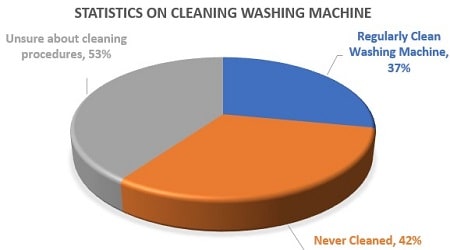Picture a scenario where your detergent compartment becomes coated with remnants of detergent, buildup from fabric softeners, and deposits of limescale.
While these might initially appear trivial, they can gradually give rise to an array of issues that impact the performance of your washing machine and the freshness of your laundry.
The accumulation of detergent within the compartment has the potential to obstruct the dispensing mechanism, thereby impeding the proper release of detergent throughout the washing cycles.
Similarly, the buildup of fabric softener can result in residual traces on your garments, causing them to lose their softness and compromising their overall cleanliness.
Moreover, the accumulation of limescale, which is frequently caused by mineral deposits in the water, can occur both inside the compartment and in a number of other parts of your washing machine.
In this article, you will learn how to clean a washing machine detergent compartment with easy to follow step by step instructions..
Table of Contents
Steps to Clean Washing Machine Detergent Drawer
Cleaning your washing machine detergent drawer might seem like a daunting task, but with the right approach, it can be a straightforward process that significantly improves your washing machine’s performance.
The below steps are suitable for most washing machine brands including:
- Samsung washing machine
- LG washing machine
- Whirlpool washing machine
- Maytag washing machine
- GE washing machine
- Kenmore washing machine
- Hotpoint washing machine
- Amana washing machine
- Speed Queen washing machine
- Miele washing machine
However, it’s highly recommended that you follow the washing machine care instructions in the user manual as there are newer variants of washing machines and for certain washers the care instructions may vary depending on the size, type and model.
Follow these steps to ensure a thorough cleaning of the detergent drawer:
Step 1: Understanding the drawer compartments
Different washing machines have various compartments in their drawers, each serving a specific purpose.
The compartments are generally labeled and used for pre-wash and main wash detergent.
The first compartment is often used for pre-wash detergent, while the second compartment is for the main wash detergent
To get a complete understanding, check out our comprehensive article on compartments in washing machine drawer here.
Gather Your Supplies
Make that you have the required materials on hand before you start.
You’ll need a toothbrush or a bottle brush, a mild dish soap, warm water, and a clean cloth.
Remove the Detergent Drawer
Open the detergent drawer and press the release lever on the inside of the drawer.
Carefully pull out the detergent drawer from your washing machine.
Different models might have varying mechanisms for removal, so consult your machine’s manual if needed.
While pressing the lever, pull the drawer out to remove it.
Also, remove the softener compartment and liquid detergent compartment (if present).
Inspect for Build-Up
Take a close look at the drawer’s compartments.
Check for any visible build-up of detergent, fabric softener, or limescale.
These deposits can accumulate over time and affect your washing machine’s efficiency.
Next, wash all the detached parts under running water.
Scrub Away Build-Up
Using a toothbrush, gently scrub away the build-up within the compartments.
Be mindful of corners and crevices where buildup often occurs.
Enhance scrubbing by combining dishwashing detergent with warm water.
Just pour the solution into the detergent compartment and use a toothbrush to scrub thoroughly.
Alternatively, you can use warm water and vinegar solution whichever is available.
Thoroughly Rinse
Once you’ve scrubbed away the build-up, rinse the detergent drawer thoroughly with warm water.
This helps remove any loosened detergent residues and ensures a clean surface.
Wipe Down the Drawer
Use a clean cloth dampened with warm water to wipe down the entire drawer, inside and out.
This step ensures the removal of any remaining residue and leaves the drawer clean and ready for reassembly.
Reassemble the Drawer (put compartments and guides back into the drawer)
Once the drawer is fully dry, reassemble and carefully slide it back into the washing machine.
Note: If you’ve encountered mold, soap scum, or grime buildup, address it by soaking the drawer in warm water and dishwashing liquid, scrubbing with a toothbrush, and rinsing well under running water.
Brand specific instructions
AEG Washing Machines
If you have an AEG washing machine, start by gently releasing the button lock and slide out the drawer, then cleanse it using warm water (refrain from using detergents or bleaches).
Then, soak the detergent dispenser drawer in a sink to loosen any soap residue before cleaning, and ensure it’s fully dry before reassembly and reinsertion into the machine.
Beko washing machine
Just press down on the fabric softener dispenser section’s plastic cover and pull the drawer gently to detach it.
Wash all removable washing machine parts in warm soapy water, employing a toothbrush or bottle cleaner for thorough cleaning.
Allow the drawer to dry, then reassemble and finally wipe down the washing machine’s detergent drawer housing with a damp cloth.
Samsung Washing Machine
According to Samsung’s official website, to clean the detergent drawer you must first open it and then press its inside release lever while pulling it out.
Next, take out the softener compartment and liquid detergent guide if applicable.
Rinse all parts under running water and scrub the drawer recess with an old toothbrush and finally reinsert compartments and guides, then push the drawer back in.
Cleaning washing machine drawer using bicarbonate of soda
To clean your washing machine drawer using bicarbonate of soda, follow these steps for an effective and natural cleaning process:
Get Your Tools Ready: You’ll require the following supplies:
- Bicarbonate of Soda (baking soda)
- White vinegar
- Sponge
- Old toothbrush
- Gloves
- Cloths
Preparation
Put on your gloves to protect your hands during the cleaning process.
Sprinkle bicarbonate of soda
Sprinkle a generous amount of bicarbonate of soda inside the drawer compartment.
This will help break down any remaining detergent or fabric softener residues and eliminate odors.
Allow the bicarbonate of soda to sit for about 15-20 minutes.
Scrubbing
Once the baking soda has had time to act, employ an old toothbrush to scrub the drawer compartment.
Focus on areas with stubborn residues or stains, the mild abrasive properties of bicarbonate of soda will help remove grime.
Also Read: Can you use baking soda as a laundry detergent
Rinsing
Dampen a cloth or sponge with white vinegar and use it to wipe down the drawer compartment once again.
This will help neutralize any remaining bicarbonate of soda and provide a thorough clean.
Reassembly and Final Steps
Upon finishing the cleaning, ensure the drawer compartment is fully dry before reassembling it in your washing machine.
To clear any lingering vinegar and baking soda traces, run an empty cycle with hot water.
Also Read: Is baking soda same as bicarbonate of soda?
The Consequences of Neglecting Detergent Drawer Cleaning
Detergent Build-Up
When detergent is repeatedly added to an unclean detergent drawer, it can accumulate and harden over time.
This build-up not only obstructs the proper functioning of the drawer but also impacts the overall efficiency of the washing machine.
Detergent build-up can block the dispenser’s mechanism, preventing the detergent from being released as intended during wash cycles.
This can lead to uneven distribution of detergent or even no detergent being dispensed at all, resulting in poorly cleaned clothes.
Fabric Softener Residue
Fabric softeners aim to create a soft, cozy feel for your clothes.
Nonetheless, their buildup in the detergent drawer can lead to a clingy residue on your garments, altering their texture and even capturing dirt and grime, thus compromising your laundry’s overall quality.
Clothes may feel stiff, and over time, the accumulation of residue can impact the appearance and longevity of your favorite outfits.
Limescale Build-Up
Limescale, which consists of mineral deposits from hard water, is a common issue in washing machines.
When limescale accumulates within the detergent drawer, it poses a twofold problem.
Firstly, it can hinder the drawer’s smooth operation, making it difficult to open and close. Secondly, limescale can gradually erode the components of the drawer, causing long-term damage.
Moreover, limescale deposits within the washing machine itself can compromise its efficiency, leading to decreased water flow and increased energy consumption.
These problems underscore the importance of regularly cleaning your washing machine detergent drawer.
By doing so, you not only prevent these issues but also contribute to the overall health and longevity of your washing machine.
Alarming Statistics on Detergent Drawer Neglect

The statistics concerning detergent drawer cleaning are quite revealing.
A study conducted by the National Association of Home Builders discovered that only 37% of homeowners make it a routine to clean their washing machine detergent drawer.
Even more concerning, a separate study by the American Cleaning Institute found that a significant 42% of individuals have never cleaned their detergent drawer.
This lack of attention to washing machine maintenance can lead to a cascade of problems affecting both the machine’s performance and the quality of your laundry.
Furthermore, a third study conducted by the Consumer Reports National Research Center revealed that a staggering 53% of individuals are unsure about how to effectively clean their washing machine detergent drawer.
This lack of knowledge exacerbates the issue and highlights the need for accessible information and guidance on maintaining essential washing machine components.
Given these statistics, it’s clear that cleaning the detergent drawer is a neglected aspect of washing machine maintenance.
Yet, equipped with proper knowledge and guidance, you can actively contribute to prolonging your washing machine’s life, preserving clothes’ cleanliness, and enhancing laundry efficiency.
Final Thoughts
Seemingly small task of cleaning your washing machine detergent drawer holds significant implications for the performance and longevity of your washing machine, as well as the quality of your laundry.
Neglecting this essential maintenance chore can lead to a variety of problems, from obstructed dispensing mechanisms due to detergent build-up, to fabric softener residue affecting the softness and cleanliness of your clothes, and the damaging effects of limescale deposits on both the drawer and the machine itself.
Alarming statistics highlight the widespread oversight in detergent drawer cleaning.
However, armed with the knowledge shared in this comprehensive guide, you can take proactive measures to keep your washing machine in optimal condition.
Don’t be part of the majority that neglects this important task, instead, develop a habit to clean the washer regularly, which results in optimum performance, and longevity of your washing machine.
Frequently Asked Questions
How to remove hardened washing powder from washing machine drawer?
To remove hardened washing powder from your washing machine drawer, first, take out the drawer and use a spoon or putty knife to scrape off loose powder. Then, soak the drawer in a mixture of equal parts white vinegar and warm water for 30 minutes, scrub it with a toothbrush or sponge, rinse with warm water, dry with a towel, and finally, reinsert the drawer into your washing machine.
How often should I clean my washing machine detergent drawer?
Clean your washing machine detergent drawer at least once a month, or more often if you use fabric softener, to prevent build-up that can affect your machine’s performance.
What can I use to clean my washing machine detergent drawer?
You can use a vinegar solution or a baking soda paste – vinegar disinfects and descales, while baking soda helps remove dirt and grime.
You May Also Like
- Fix Your Leaking Washing Machine Drawer in 10 Minutes
- Washing Machine Drawer Not Emptying? Here’s the Fix!
- How To Replace a Washing Machine Detergent Drawer?
- How to clean Maytag washing machine? (Comprehensive guide)
- How to clean the filter in a Godrej Allure washing machine?
- Why is homemade laundry detergent or soap bad? (Explained)
- What are Plant-based Detergents? (Explained)
- Can Front Load Detergents be used in the Top Load Washers?
- Where do you put the detergent in a Speed Queen?





